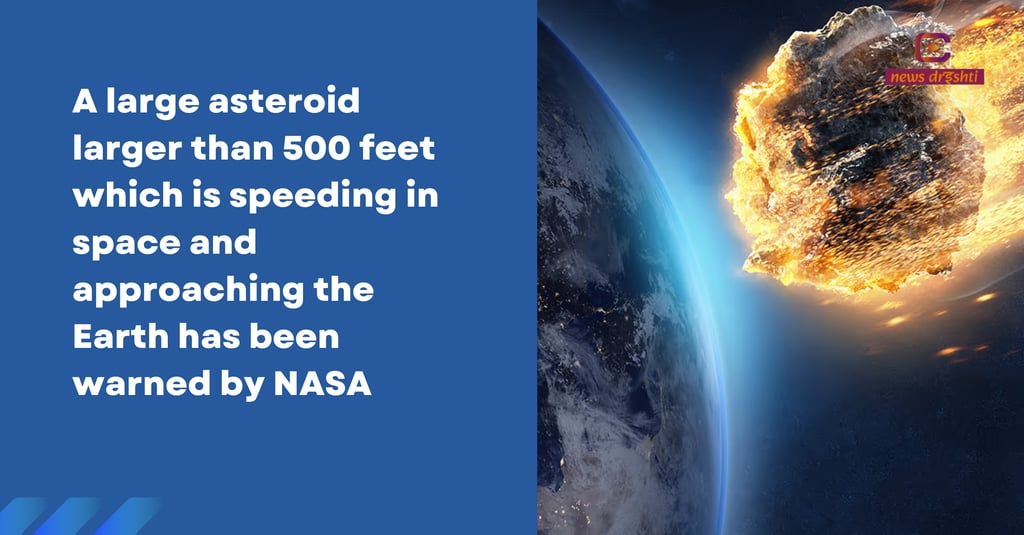NASA Monitors Large 500+ Ft Asteroid Approaching Earth at High Speed
NASA has categorized a large asteroid, over 500 feet in size, as potentially hazardous. While it poses no collision threat in the next 100 years, the asteroid's approach highlights Earth's ongoing vulnerability to space threats. Learn about asteroid formation and past impacts.
NATIONAL


Boys if we have a gargantuan asteroid heading towards the Earth at an extremely fast speed! NASA is currently monitoring an asteroid it has categorized as dangerous There is today an asteroid that we have a list for by the National Aeronautics and Space Administration (NASA).
NASA came forward to Fox News Digital to explain that the asteroid is roughly 350 meters long and 180 meters wide and is hence approximately 1150 ft front to rear by 590 ft top to bottom.
Astronomers pointed out that an asteroid of this size would approach the Earth at this distance in the next five to ten years at most, Davide Farnocchia, a navigation engineer at the NASA Jet Propulsion Laboratory said to the medics. And they say that there is a giant asteroid which is threatening to strike Earth, it is as big as a stadium. Of course, when this arrived on the planet, the last time that an asteroid as huge as this attacked the planet was in Russia in the year 2013 as noted by the expert.
Is it possible that this asteroid endangers the existence of the Earth?
‘We check it for the future and the next hundred years’, Farnocchia speaking to the media. “And there is no such a chance of collision in the next hundred years. ”
“The next five objects within 4. 6 million miles (7. 5 million kilometers or 19. 5 times the distance to the moon) are shown on the dashboard; objects larger than about 150 meters that can approach the Earth within this distance are potentially hazardous,” the expert added.
It has also been calculated that the asteroid that led to the extinction of dinosaurs was approximately between 10-15 Km in size and after that they made a crater with a diameter of 150 Km.
On Tuesday Morning 2024, ON was, therefore, traveling towards its destination at a velocity of about 8. 8 kilometers per second.
How are asteroids formed?
Asteroids: are aggregates of particles and substances, which have been present in the early stage of the solar system say about the 4 ^{th}. 6 billion years ago. During the formation of the planets dust and gas were built up in the solar nebula and thus planetesimals evolved through the process of accretion. These planetesimals turned into larger celestial formations like planets as some others stayed little formations and they are called asteroids today. Most of the asteroids move in a region in space known as the asteroid belt, situated between Mars and Jupiter; Jupiter was so huge that it attracted many of the debris particles in the solar system forming a big planet rather than small rocky bodies. Such formations are artifacts of the early solar system and constitute significant indicatives of the young solar system formation and evolution.
Just try to picture what a few of these space rocks mean to our dear planet not to talk of the disastrous number. It is argued that after Earth's formation, many large asteroid impacts occurred as the geology of the Earth was evolving. Of course, one of the most astonishing is the Chicxulub impact which occurred about 66 million years ago and which claimed the dinosaurs’ lives. It also eradicated nearly three-quarters of the life forms of biological nature on planet Earth. This one is a huge asteroid which is about 10kms in size; it led to massive fires and also generated tsunamis. It amplified an effect known as a nuclear winter when they shifted to the atmospheric tierce fractional layers.
Other smaller effects have occurred: like the Tunguska event of July 1908 where an explosion destroyed 2000 sq km of Siberia’s forests. Of such a nature large changes are short in occurrence on Earth, albeit.
